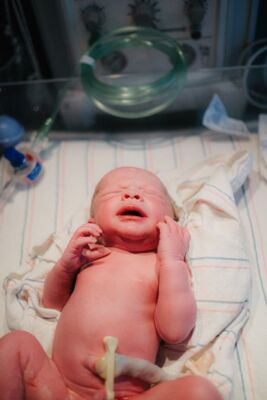Umbilical cord care
The umbilical cord connects you to your baby whilst they are in the womb, it delivers the oxygen and nutrients they need to grow during your pregnancy.

Contact information for your local maternity service
East and North Hertfordshire (The Lister Hospital): 01438 284 124
West Essex (The Princess Alexandra Hospital): 01279 827 286
South and West Hertfordshire (Watford General Hospital): 01923 217 343
Umbilical cord care
After your baby has been born, the cord will be clamped and cut. The cord doesn’t contain any nerves, so neither you nor your baby will feel anything. A small stump will be left and it will fall off naturally. Do not pull, cut or tamper with the cord.
Caring for your baby’s umbilical stump
- Clean it with water, especially if it comes into contact with any wee or poo from their nappy.
- Ensure the cord is properly dried after cleaning.
- Expose the belly button to the air by rolling back the top of the nappy. Make sure your baby’s nappy does not press too tightly on their cord, as this can press the clamp uncomfortably against their tummy.
- After a few days, the cord will dry, become darker in colour and fall off.
Most umbilical stumps will heal with no problems, but it’s important to be aware of the signs of infection. If you notice any of the following signs, speak to your GP:
- A strong and unpleasant smell
- The area around the umbilical stump becoming red, inflamed or oozing discharge
- Bleeding from the area
Umbilical granuloma
An umbilical granuloma is an overgrowth of tissue during the healing process of the belly button (umbilicus). It usually looks like a soft pink or red lump and is often wet or leaks small amounts of clear or yellow fluid. It is most common in the first few weeks of a baby’s life. The exact cause of this overgrowth is unknown.
Seek advice from your health visitor if you think your child might have an umbilical granuloma.
Umbilical hernia
Rarely an unbilical hernia can develop after the cord has fallen off. An umbilical hernia will appear as a painless lump where the umbilical cord used to be, it might even change in size if they are sitting or lying down, laughing, crying or coughing.
Most umbilical hernias will heal on their own before your child’s first birthday, but you should speak to a GP if you’re concerned about your child’s hernia.
More help and support
Getting to know your newborn - NHS (www.nhs.uk)
Umbilical hernia repair - NHS (www.nhs.uk)
Umbilical granuloma – PT-Understanding-umbilical-granuloma-FINAL-VERSION-10.8.22.pdf (ihv.org.uk.)
Umbilical cord care and signs of infection The first few weeks of your baby's life | Tommy's (tommys.org)

